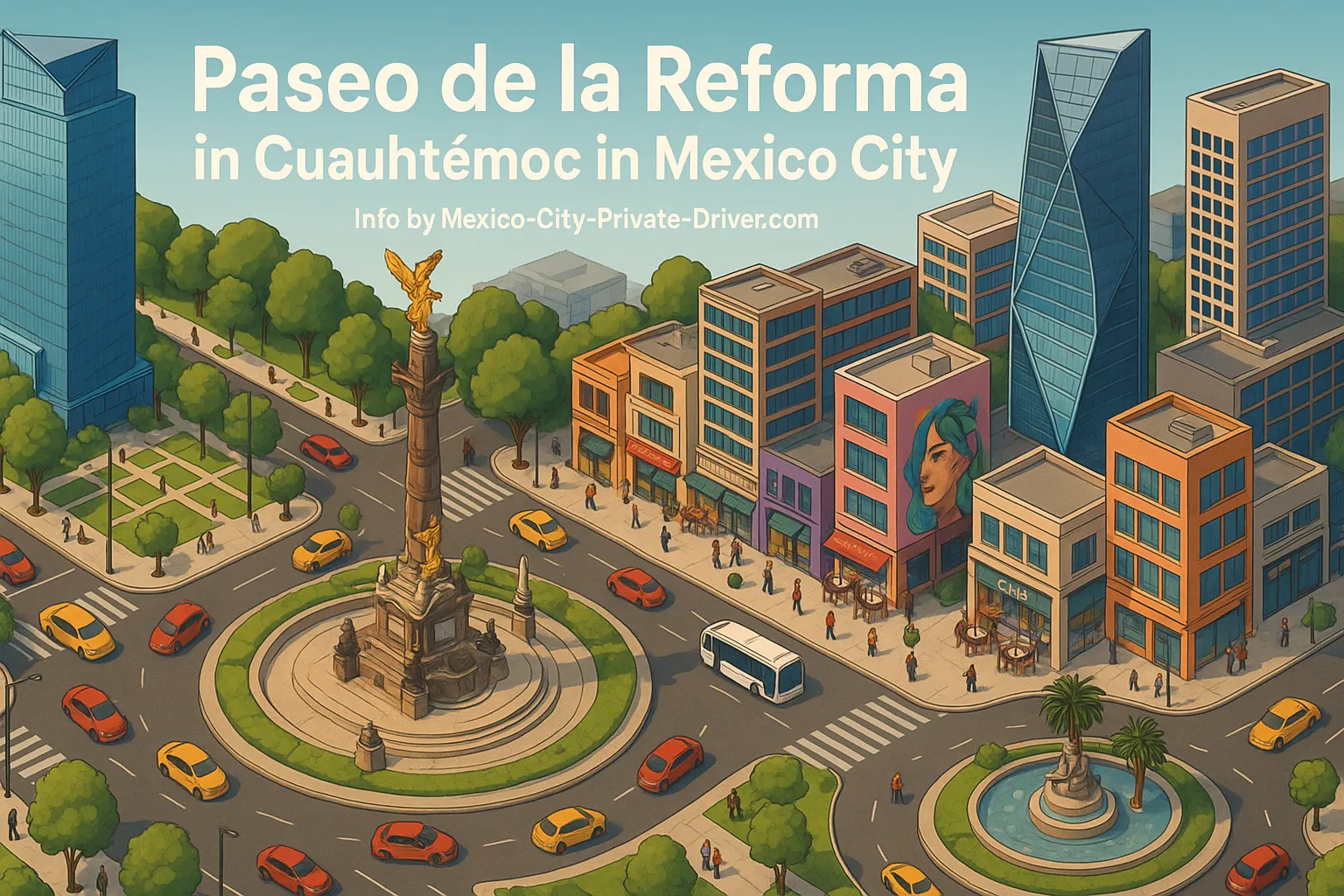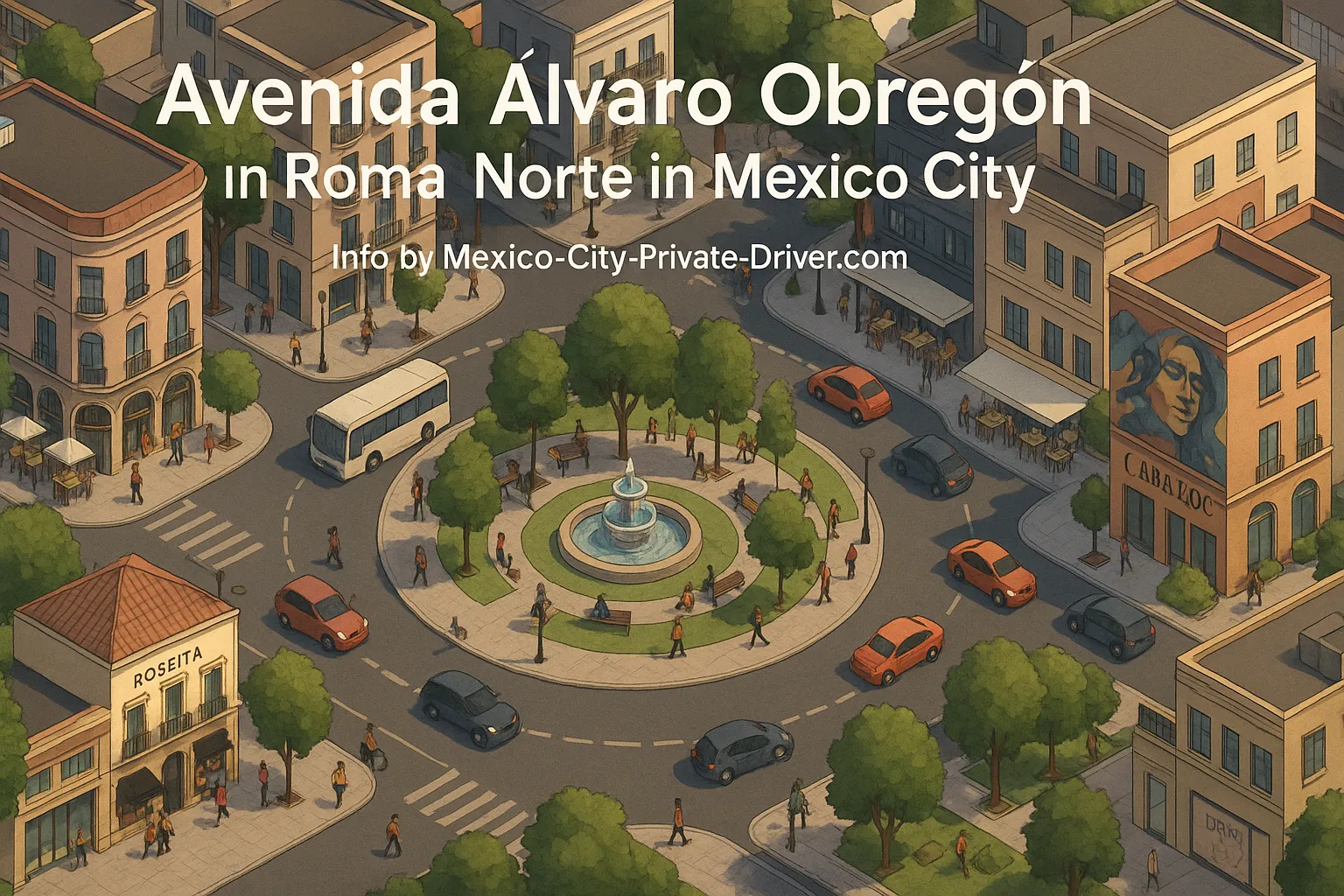República de El Salvador — A driver’s view from the heart of Centro Histórico
I’m the owner and lead driver at Mexico-City-Private-Driver.com. I have spent thousands of hours behind the wheel in Mexico City’s Centro Histórico, bringing guests to and from streets like República de El Salvador and the surrounding blocks. In this article I’ll give you a practical, on-the-ground guide to República de El Salvador — what it’s like to drive there, parking and pickup tips, nearby landmarks, public-transport connections, and at least one genuine “wow” moment that makes the street memorable. I’ll also share the small, tactical tricks only a seasoned private driver would know to make your visit smoother and more enjoyable.
Where República de El Salvador sits in the Centro Histórico
República de El Salvador is one of the many “República de…” streets that cut through Mexico City’s Centro Histórico. It’s part of the dense grid of colonial- and early-20th-century streets packed with historic façades, small shops, cantinas, and government offices. When guests ask me to include República de El Salvador on an itinerary, they’re usually combining it with time at the Zócalo, Alameda Central, Palacio de Bellas Artes, or a stroll through the pedestrianized Calle Francisco I. Madero. It’s a short, intimate street experience rather than a long boulevard like Reforma.
Street names you might see (SEO-friendly variations)
- República de El Salvador
- Calle República de El Salvador
- Avenida República de El Salvador
- República del Salvador (common variant in searches)
- República de El Salvador, Centro Histórico
Hard facts a private driver needs to know
Driving and working in Centro Histórico means dealing with a mix of narrow streets, heavy pedestrian traffic, short-term delivery vehicles, and municipal regulations. Below I list the key operational points I use every day when working around República de El Salvador.
Street layout and traffic patterns
- Narrow, mostly one-way streets: Many streets in the Centro Histórico are narrow and often one-way; that can affect routes and increase time for short trips. I always check the direction of travel before committing to a drop-off.
- High pedestrian density: Foot traffic is heavy most of the day — especially around midday and late afternoon. Expect lots of pedestrians crossing between shops and historic sites.
- Delivery windows: Commercial deliveries typically happen early in the morning; by late morning and afternoon loading zones become congested with vans and trucks.
- Traffic bottlenecks: Major surface arteries that serve the historic center (like Eje Central, 20 de Noviembre, or nearby Paseo de la Reforma) can have heavy traffic during rush hours and event days.
Parking and drop-off (insider rules)
Official parking is scarce on interior Centro Histórico streets. As a private driver I rarely try to park directly on República de El Salvador unless I have a confirmed private garage or a temporary loading/unloading permit for 10–15 minutes. Instead I use the following tactics:
- Drop-off/pickup at wider avenues: I often request passenger loading on wider, regulated streets that are a 1–5 minute walk away — avenues such as Eje Central, Calle 20 de Noviembre and pedestrian plazas near Madero. This reduces the risk of fines or being boxed in by delivery trucks.
- Use of private garages: When guests are staying at a hotel like Gran Hotel Ciudad de México or Hotel Zócalo Central, I coordinate with the hotel garage for secure parking and quick guest transfer.
- Short-term street parking: If I must stop on República de El Salvador, I aim for early morning or late evening when traffic is light, and I never leave the vehicle unattended.
- Avoid double-parking: Double-parking is enforced and can get the car ticketed or towed — especially near government buildings.
Local regulations and practicalities
- Vehicle access and enforcement: Centro Histórico has active traffic enforcement. Police and transit authorities ticket cars blocking access or in restricted zones. I keep all vehicle documentation up-to-date and advise guests to avoid independent parking on interior streets.
- “Hoy No Circula” and emissions controls: Mexico City’s emissions programs apply here. If you’re using a rental or personal car, check restrictions for the day and the vehicle’s hologram status. As your private driver, I handle this for you.
- Pedestrianized streets and event closures: Streets and plazas get pedestrian-only periods during festivals, government ceremonies, or repairs. I monitor municipal announcements and coordinate alternate routes as needed.
Public transportation access near República de El Salvador
One of the conveniences of the Central Historic area is the number of public transit options within an easy walk. As a private driver I use the Metro and Metrobús knowledge to time pickups and plan routes that avoid the busiest metro entry points at peak times.
Stations and connectivity
- There are multiple Metro and Metrobús stations within walking distance of the Centro Histórico core — great for guests who arrive by train and then want a short private transfer to hotels or nearby neighborhoods.
- For airport transfers I usually meet guests at hotel lobbies (Gran Hotel Ciudad de México, Hotel Zócalo Central, or Reforma hotels) where arrivals are smoother than on narrow side streets.
Why a private driver helps with public-transport-based plans
- Time optimization: I avoid walking guests from crowded stations during peak times, saving time and stress.
- Door-to-door comfort: After a long flight or a full day’s touring, guests appreciate a vehicle that waits at an agreed point rather than fighting the crowd.
- Local language and ticketing help: I can coordinate metro timing and help buy tickets if guests prefer to start with public transit and finish with a private vehicle.
Nearby landmarks and attractions I pair with República de El Salvador
República de El Salvador works best as part of a walkable circuit through Centro Histórico. When I design private driving routes, I often combine a short stop on República de El Salvador with these nearby highlights:
- Zócalo / Plaza de la Constitución: The symbolic heart of Mexico City, with the Cathedral and National Palace nearby. It’s easy to arrange a quick drop-off here.
- Palacio de Bellas Artes and Alameda Central: A stunning venue and park — great combined with a rooftop coffee or museum visit.
- Casa de los Azulejos and Calle Madero: Madero is pedestrianized and full of shops and historic façades; Casa de los Azulejos is a popular photo stop.
- Torre Latinoamericana: Short walk from pedestrian corridors and offers one of the best central city panoramic views.
- Mercado de San Juan and local cantinas: Food stops where many visitors taste authentic Mexico City specialties.
Sample private-drive itineraries centered on República de El Salvador
- Short cultural loop (2–3 hours): Pickup at hotel in Condesa/Roma → drive to República de El Salvador (drop-off if guests want a short walk) → walk to Palacio de Bellas Artes and Alameda → coffee at a nearby café → rooftop photo stop at Torre Latinoamericana → return to hotel.
- Half-day historical immersion: Pickup at Polanco hotel → quick drive on Reforma with photo stops → drop at Zócalo near República de El Salvador area → guided walk through Catedral and National Palace → lunch at a Cantina or Mercado de San Juan → drive back via Reforma.
- Evening dinner route: Pickup from hotel or Airbnb → early evening scenic drive through Reforma and Monumento a la Independencia → drop-off near a restaurant in Centro Histórico close to República de El Salvador → wait or return for pickup after dinner.
Local tips only a private driver would tell you
Here are the small, practical tips I share with every client. They come from years of navigating the Centro Histórico with luggage, elderly travelers, or groups who demand punctuality and comfort.
- Agree on an exact small-venue pickup point: Saying “meet me at República de El Salvador” is too vague. Tell me the exact door, café, or intersection. I’ll coordinate by phone and pick you up where I can legally stop.
- Time of day matters: If you want photos free of crowds, plan early morning (before 9:00) on weekdays. Afternoon and weekends are busier with tourists and school groups.
- Luggage strategy: I bring a trolley or can help carry luggage across short cobbled stretches — much easier than trying to park against a sidewalk where vendors or vendors’ stalls block access.
- Bag your valuables: Some side streets have pickpocketing incidents. I remind guests to secure phones and wallets when walking away from the vehicle.
- Short-distance walking saves time: Often the fastest way to get guests to a restaurant or a rooftop is to drop them five minutes’ walk away and meet them after — much faster than trying to wind a car through narrow streets and double parking.
- Communicate about noise: Centro Histórico can be lively late into the evening; if you have light sleepers, request a quieter hotel room or plan pickups after 11pm when traffic is calmer.
Benefits for visitors who use a private driver around República de El Salvador
Many visitors ask me: why hire a private driver when the Centro Histórico is so walkable? Here are the reasons my clients keep returning:
- Time efficiency: I reduce walking time and wait time. If you have limited hours, private transport lets you cover more without the stress of navigation.
- Flexibility: I can adjust routes on the fly for shop openings, museum entry times, or weather.
- Local coordination: Need a last-minute restaurant reservation, private garage access, or a quick detour to a pharmacy? I handle it.
- Comfort and safety: After a full day of touring, having a climate-controlled car to rest in while traffic eases is priceless.
- Insider knowledge: As a local driver I know where to park, where to avoid, and which cafés are reliable for a quick stop.
Hotels and pickup references I commonly use
Many visitors to Centro Histórico stay in or near a set of reliable hotels. When you book my service I coordinate exact meeting points — often hotel lobbies because they provide safe, accessible pickup and short-term parking in attached garages.
- Gran Hotel Ciudad de México
- Hotel Zócalo Central
- Hotels around Paseo de la Reforma and Avenida Juárez (handy if you’re coming from Condesa or Polanco)
- Airbnb/short-term rentals — I always ask for the nearest clear curbside landmark to avoid confusion
Custom routes and day-trip suggestions that include República de El Salvador
Below are a few curated routes I offer clients who want to maximize their time in and around the Centro Histórico while enjoying comfortable transport.
Route A — Classic Centro Histórico panorama (3–4 hours)
- Pickup at your hotel (Roma/Condesa/Polanco) → scenic drive along Paseo de la Reforma (photo stop at Ángel de la Independencia if requested).
- Drop-off near República de El Salvador for a short walk through historic streets and a coffee stop.
- Visit Palacio de Bellas Artes and Alameda Central (short walk)—I wait or return at a preset time.
- Quick rooftop break at Torre Latinoamericana or lunch in a traditional cantina.
- Return drive through Reforma to your hotel or onward to Coyoacán if desired.
Route B — Food and market micro-tour (half day)
- Pickup at hotel → Mercado de San Juan for gourmet market browsing.
- Short stop on República de El Salvador for a local bakery or cantina experience.
- Lunch at a recommended Centro Histórico restaurant — I know quiet back doors for groups.
- Optional short shopping walk along Madero or to specialty stores near the Zócalo.
Route C — The long photo day (full day)
- Early pickup → sunrise shots near the Zócalo and Cathedral.
- Mid-morning walk on República de El Salvador and adjacent streets to capture colonial details and façades.
- Afternoon at Museo Nacional de Arte or Palacio de Bellas Artes, then sunset views on Paseo de la Reforma.
One real “wow” story from República de El Salvador — the moment that still gives me goosebumps
I keep an eye out for small, human moments that make the Centro Histórico feel alive. One weekday morning, I drove a multi-generational group I often work with: a grandfather, his adult daughter, and two grandkids. They wanted to see a street the grandfather remembered from his childhood — República de El Salvador — because he said his first job was on a block nearby. I dropped them off at a corner where old jewelry shops and a timeworn bakery still hugged the pavement.
They walked slowly, touching the carved doorframes and pausing beneath a colonial balcony that had been painted generations ago. After about ten minutes, an elderly shopkeeper opened his door, surprised to hear Spanish with an accent from a different state. The grandfather explained his visit. The shopkeeper led them into a small courtyard — a hidden, unexpectedly beautiful space lined with tiles and succulents that you wouldn’t notice from the street. He produced a yellowed ledger and, after a few minutes of comparison, confirmed the grandfather’s name and showed him a faded photograph of a street scene from decades earlier.
The grandfather started to cry — not out of sadness, but recognition. The photograph showed the same balcony the grandfather had just admired, with a truck, children playing, and a market stall. He realized he had walked this patch of cobblestones as a boy. The shopkeeper told stories of that neighborhood: how people moved, where a long-gone cinema used to stand, and the recipe for a legendary scone the shop still baked. My clients asked if I could wait. I stayed in the car, windows down, listening to them laugh and cry in a way a driver rarely gets to witness.
That day I learned how these streets hold personal histories — micro memoirs embedded in façades, tiles, and doorways. That small courtyard and the ledger were a reminder that Centro Histórico isn’t just monuments; it’s a living archive of personal stories. As a private driver I get to be part of those reconnections.
Safety, accessibility, and family-friendly advice
- Accessibility: Sidewalks in the Centro Histórico vary. Some have ramps, but many historic doorways and stores have steps. If someone in your party has mobility issues, let me know — I can select the smoothest paths and drop-off points.
- Night safety: The Centro Histórico is lively after dark. Stick to well-lit main streets and plan pickups ahead of time. I’ll wait in a location where the car can legally stop and where lighting and foot traffic make guests feel secure.
- Children and strollers: Cobblestone can be rough on wheels. I bring a small stroller pad, and we can park a short walk away to avoid bumpy stretches.
Photos, timing, and seasonal notes
Photography is one of the best reasons to move through República de El Salvador with a private driver. I often cue guests for light and angle, and I can shift schedule to match soft morning light or golden hour. Few practical points:
- Golden hour: Early morning or just before sunset gives façades a warm glow — perfect for photos.
- Weather: Mexico City weather can change quickly. I keep umbrellas, bottled water, and a small towel in the car.
- Festivals and closures: During civic holidays the Zócalo and adjacent streets can host large events that reroute traffic. I monitor municipal bulletins and call ahead for hotel
Martin Weidemann is a digital transformation expert and entrepreneur with over 20 years of experience leading fintech and innovation projects. As a LinkedIn Top Voice in Digital Transformation and contributor to outlets like Forbes, he now brings that same expertise to travel and mobility in Mexico City through Mexico-City-Private-Driver.com. His focus: trustworthy service, local insights, and peace of mind for travelers.


